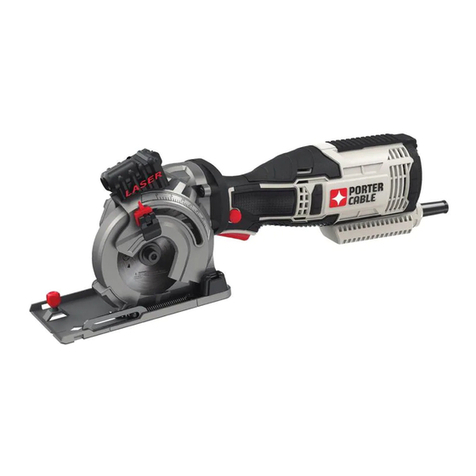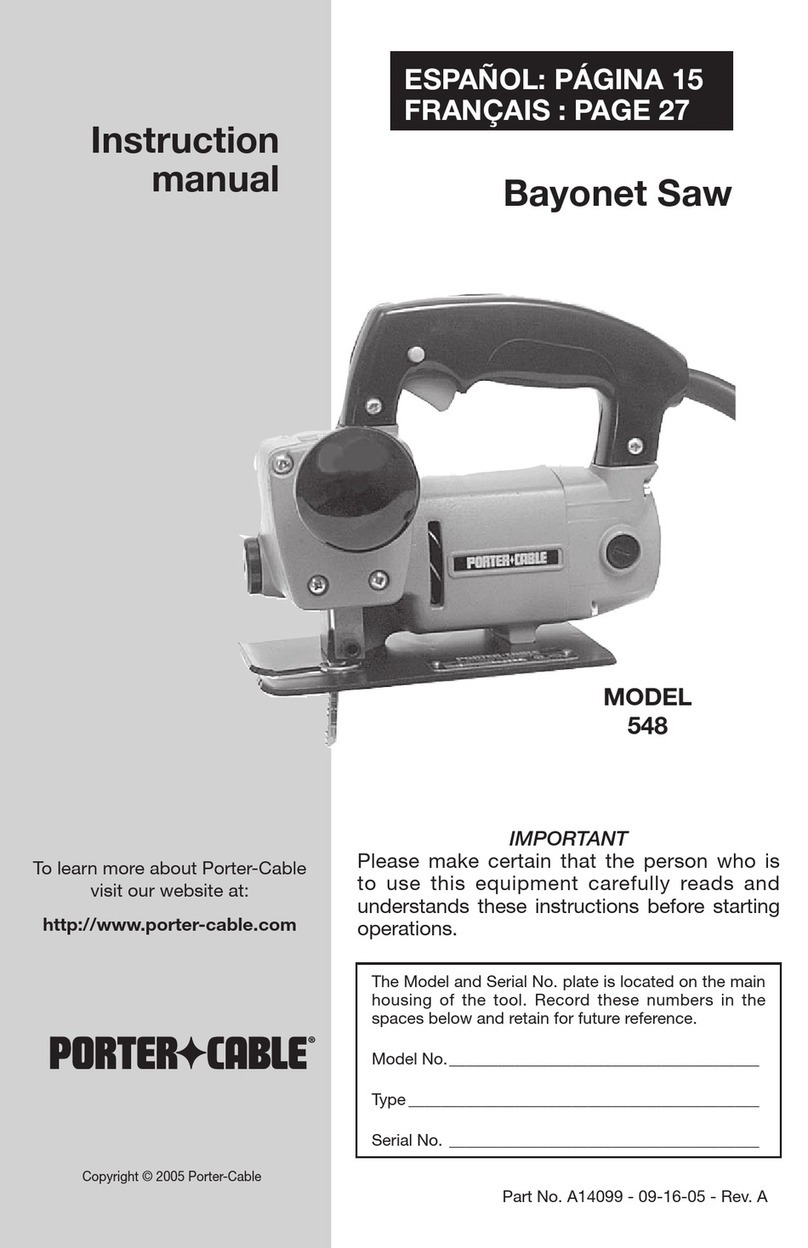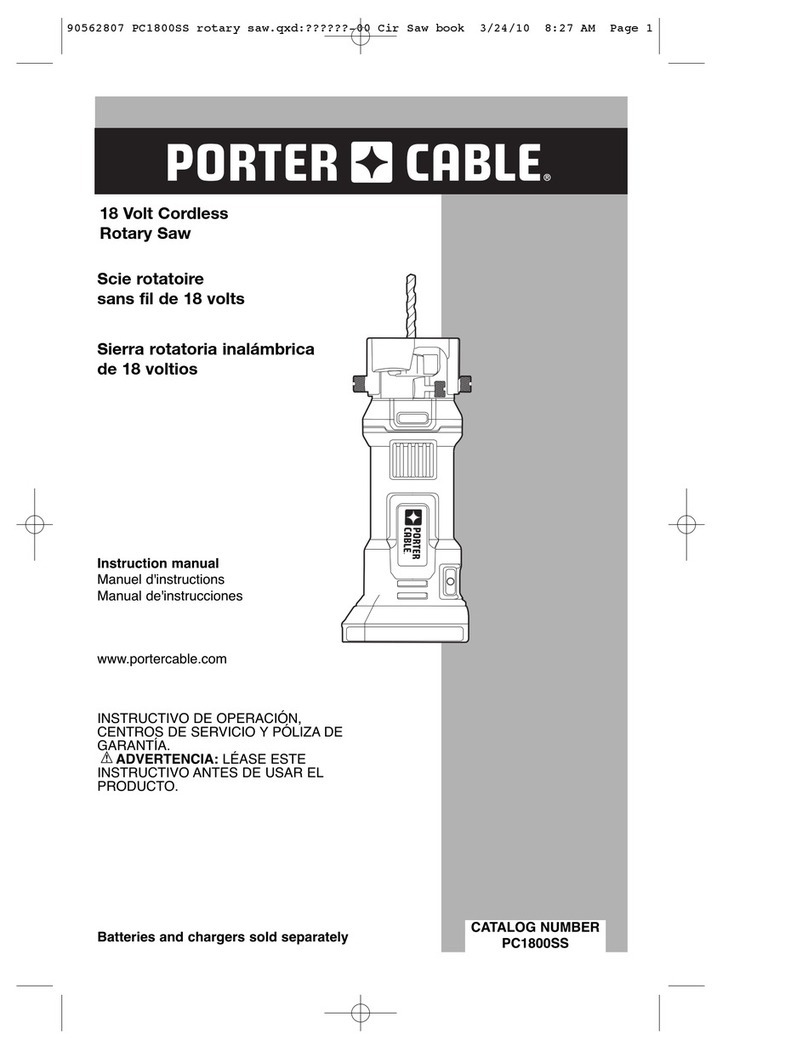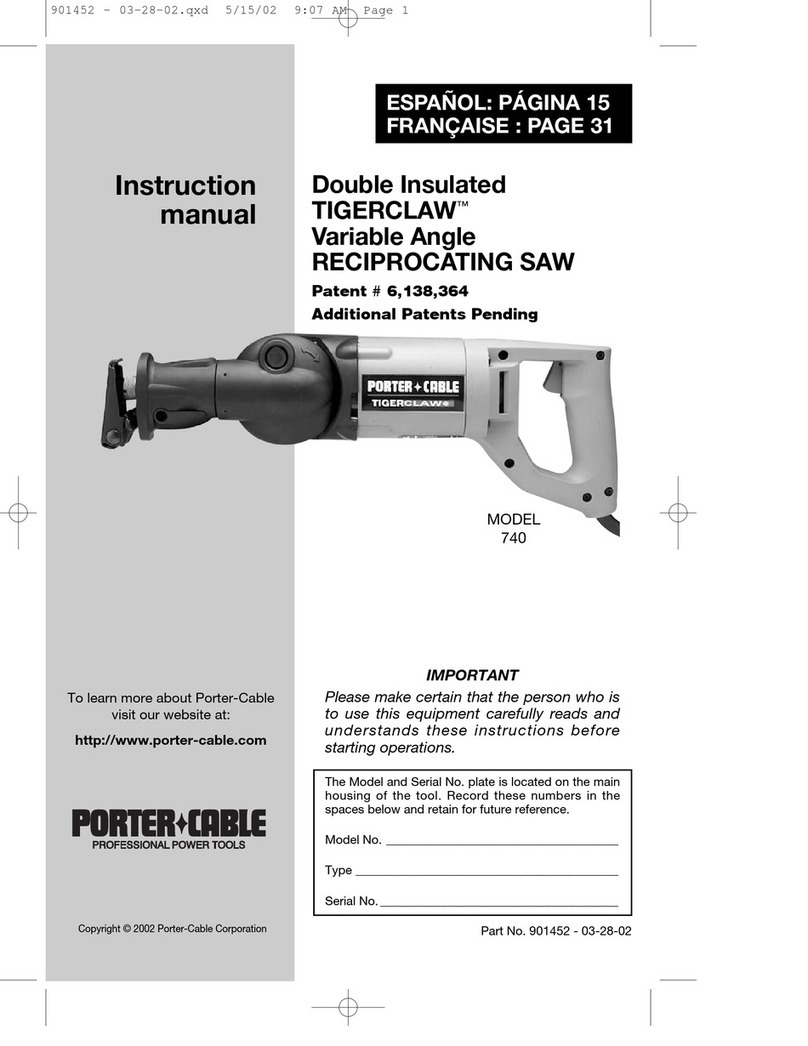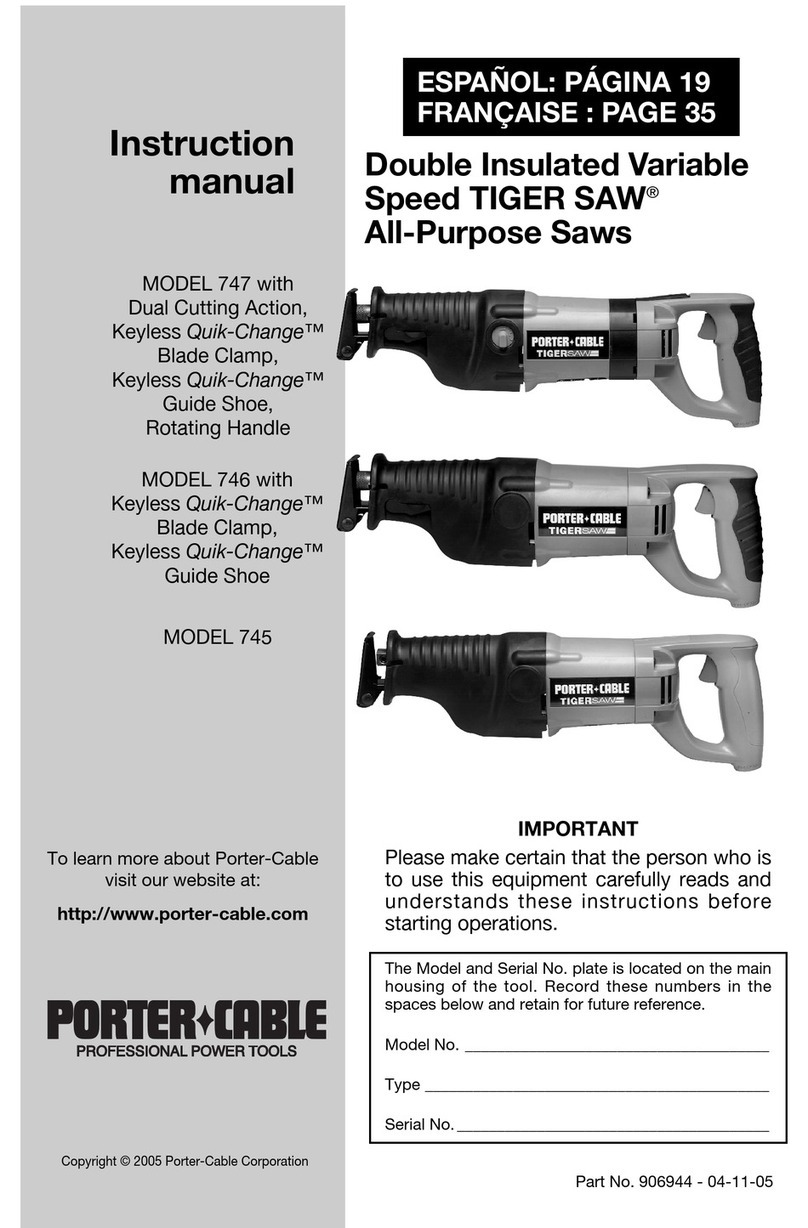
5
FAILURE TO FOLLOW THESE RULES MAY RESULT IN SERIOUS PERSONAL INJURY.
ADDITIONAL SAFETY RULES FOR MITER SAWS
1.DO NOT OPERATE THISMACHINE until itis completely assembled and
installed according to the instructions.A machine incorrectly assembled
can cause serious injury.
2.OBTAIN ADVICE from yoursupervisor,instructor,oranotherqualified
person ifyou are notthoroughly familiarwith the operation ofthis
machine.Knowledge is safety.
3.FOLLOWALLWIRINGCODESandrecommended electricalconnections
to preventshock orelectrocution.
4.DO NOT OPERATE ON ANYTHING OTHER THAN THE DESIGNATED
VOLTAGE forthe saw.
5.SECURE THE MACHINE TO A STABLE SUPPORTING SURFACE.
Vibration can possibly cause the machine to slide,walk,ortip over,
causing serious injury.
6. USE ONLY CROSSCUT SAW BLADES. Use only zero-degree or
negative hook angles when using carbide-tipped blades.Do notuse
blades with deep gullets.These can deflectand contactthe guard,and
can cause damage to the machine and/orserious injury.
7.USE ONLY BLADES OF THE CORRECT SIZE AND TYPE specified for
this toolto preventdamage to the machine and/orserious injury.
8.MAKE CERTAIN BLADE ROTATES IN CORRECT DIRECTION and
thatthe teeth atthe bottom ofthe blade pointto the rearofthe saw.
9.USE BLADE GUARD AT ALL TIMES. Don’tspray any lubricants or
cleaners
(
particularly spray oraerosol
)
in the vicinity ofthe plastic guard.
The polycarbonate materialsued in the guard is subjectto attack by
certain chemicals.
10.USE A SHARP BLADE. Check the blade to see ifitruns true and is free
from vibration.A dull blade ora vibrating blade can cause damage to the
machine and/orserious injury.
11.DON’T WEDGE ANYTHING AGAINST THE FAN to hold the motor
shaft.
12.DON’T USE ABRASIVE WHEELS. The excessive heatand abrasive
particles generated by them will damage the saw.
13.INSPECT BLADE FOR CRACKS orotherdamage priorto operation.A
cracked ordamaged blade can come apartand pieces can be thrown at
high speeds,causing serious injury.Replace cracked ordamaged blades
immediately.
14.CLEAN THE BLADE AND BLADE FLANGES priorto operation.
Cleaning the blade and flanges allows you to check forany damage to the
blade orflanges.A cracked ordamaged blade orflange can come apart
and pieces can be thrown athigh speeds,causing serious injury.
15.ALWAYS USE THE KERF PLATE AND REPLACE THIS PLATE WHEN
DAMAGED. Small chip accumulation underthe saw may interfere with
the saw blade ormay cuase instability ofworkpiece when cutting.
16.USE ONLY BLADE FLANGES specified forthis toolto preventdamage
to the machine and/orserious injury.
17.CLEAR THE AREA OF FLAMMABLE LIQUIDS and/orgas priorto
operation.Sparks can occurthatwould ignite the liquids and cause a fire
oran explosion.
18.CLEAN THE MOTOR AIR SLOTS ofchips and sawdust.Clogged motor
airslots can cause the machine to overheat,damaging the machine and
possibly causing a shortwhich could cause serious injury.
19.TIGHTEN THE TABLE CLAMP HANDLE and any otherclamps priorto
operation.Loose clamps can cause parts orthe workpiece to be thrown
athigh speeds.
20.NEVER START THE TOOL with the blade againstthe workpiece.The
workpiece can be thrown,causing serious injury.
21.KEEP ARMS, HANDS, AND FINGERS away from the blade to prevent
severe cuts.Clamp all workpieces thatwould cause yourhand to be in the
“Table Hazard Zone”
(
within the red lines
)
.
22.DON’T PLACE HANDS IN THE BLADE AREA when the saw is
connected to a powersource.
23.DON’T REACH UNDERNEATH THE SAW unless itis unplugged or
turned off.The saw blade is exposed on the underside ofthe saw.
24.ALLOW THE MOTOR TO COME TO FULL SPEED priorto starting cut.
Starting the cuttoo soon can cause damage to the machine orblade
and/orserious injury.
25.NEVER REACH AROUND orbehind the saw blade.A moving blade can
cause serious injury.
26.NEVER CUT FERROUS METALS ormasonry.Eitherofthese can cause
the carbide tips to fly off the blade athigh speeds causing serious injury.
27.NEVER CUT SMALL PIECES. Cutting small pieces can cause yourhand
to move into the blade,resulting in serious injury.
28.NEVER LOCK THE SWITCH in the “ON”position.Setting up the nextcut
could cause yourhand to move into the blade,resulting in severe injury.
29.NEVER APPLY LUBRICANT to a running blade.Applying lubricantcould
cause yourhand to move into the blade,resulting in serious injury.
30.DO NOT PERFORM FREE-HAND OPERATIONS.Hold the work firmly
againstthe fence and table.Free-hand operations on a mitersaw could
cause the workpiece to be thrown athigh speeds,causing serious injury.
Use clamps to hold the work when possible.
31.CUTTINGHEAD MUST RETURN QUICKLY TO THE FULL UP
POSITION.Failure to do so will notallow the lowerguard to
operate properly and may resultin personalinjury.
32.TURN OFF THE MACHINE and allow the blade to come to a complete
stop priorto cleaning the blade area orremoving debris in the path ofthe
blade.A moving blade can cause serious injury.
33.PROPERLY SUPPORT LONG OR WIDE WORK-PIECES. Loss of
controlofthe workpiece can cause injury.
34.NEVER PERFORM LAYOUT, ASSEMBLY, OR SET-UP WORK on the
table/work area when the machine is running.A sudden slip could cause
a hand to move into the blade.Severe injury can result.
35.DON’T ALLOW ANYONE to stand behind the saw.
36.TURN THE MACHINE “OFF”, disconnectthe machine from the power
source,and clean the table/work area before leaving the machine.LOCK
THE SWITCH IN THE “OFF” POSITION to preventunauthorized use.
Someone else mightaccidentally startthe machine and cause injury to
themselves.
37.BEFORE OPERATING THE SAW, check and securely lock the bevel,
miter,and sliding fence adjustments.
38.ADDITIONAL INFORMATION regarding the safe and properoperation
ofpowertools
(
i.e.a safety video
)
is available from the PowerTool
Institute,1300 SumnerAvenue,Cleveland,OH 44115-2851
(
www.
powertoolinstitute.com
)
.Information is also available from the National
Safety Council,1121 Spring Lake Drive,Itasca,IL 60143-3201.Please
referto the American NationalStandards Institute ANSI01.1 Safety
Requirements forWoodworking Machines and the U.S.Department
ofLaborregulations.
ADDITIONAL SAFETY RULES FOR THE LASER
LASER LIGHT - DO NOT STARE INTO THE BEAM, APERTURE, orinto a
reflection from a mirror-like surface
(
Figs.1and 1A
)
.
AVOID EXPOSURE - THE LASER LIGHT IS EMITTED FROM THE FRONT
GUARD APERTURE. Use ofcontrols oradjustments,orperformance of
procedures otherthan those specified herein may resultin hazardous laser
lightexposure.
DO NOT DISASSEMBLE THE LASER MODULE. The laseris a CLASS II
LASER PRODUCT thatcan emitlaserpowerup to 1 mW MAX at635 nm
thatcould resultin exposure with the module disassembled.The laserunit
complies with 21 CFR 1040.10 and 1040.11.
USE OF CONTROLS OR ADJUSTMENTS OR PERFORMANCE OF
PROCEDURES OTHER THAN THOSE SPECIFIED HEREIN MAY RESULT
IN HAZARDOUS RADIATION EXPOSURE.

